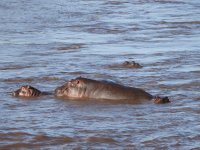Today we had a full day in the Mara Triangle, this region of the Maasai Mara is overall seen as a better area for birding purposes due to the smaller number of visitors and it is particular well represented in the raptor and wading bird groups. Before heading out, we noticed a new mammal in the trees right above our rooms in the shape of Bush Hyrax and the early morning drive had us going towards the Mara River in hopes to find some special birds in the woodlands surrounding the river. On the drive there, a pair of Temminck's Courser were seen by everyone in the group, but the first new bird of the trip was the Fan-tailed Grassbird, a weird grassland specialty with a patchy range throughout Sub-Saharan Africa. Once we reached the woodland, a small group of Meyer's Parrot made their presence known from the top of the tree canopy, a Schalow's Turaco was also heard but sadly never seen, thus leaving the last potential turaco of the trip in the heard-only category. Driving back close to the river we noticed the bloats of Common Hippopotamus and on the drive towards the Western corner of the triangle we saw a distant pair of Black Rhinoceros.
As the day heated up, raptor activity began to rise as well, with 11 species seen this morning! Some of the highlight birds include Lappet-faced Vulture, Brown and Black-chested Snake-Eagle and an out-of-season Eurasian Marsh-Harrier. Looking at the swallow flocks eventually got us views of Rufous-chested Swallow and in one of the pools we eventually found a much-more cooperative Rufous-bellied Heron than the one seen the previous day. A quick bathroom break in the Western gate of the Mara also had us take the commemorative trip photo and driving back to the lodge had us find some species we had missed so far for the day, but new birds were few and far in-between, with some relatively expected and large species like African Woolly-necked and Saddle-billed Stork being oddly missing. However, we were able to connect with one of the best birds in the region when I erroneously pointed out a "Striated Heron" on top of a bush, Alex quickly backtracked when I said that and sure enough, the bird was something much better as it was a Dwarf Bittern! Leaving with that happy note back to the lodge, we had lunch and a nap break before hitting the road in the afternoon.
As it was the last day, some members of the group decided to stay back and properly pack up, but some of us wanted more of the Mara and sure enough this afternoon drive was going to give us that. Soon after leaving the lodge, we spotted a faraway kill that contained the typical scavengers in these savannas as Black-backed Jackal, Spotted Hyena, White-backed and Hooded Vulture were all taking scraps from the kill. Moving from there we encountered a three birds that represent one of the highlights of the Mara, Southern Ground-Hornbill, we enjoyed the bird forage for a couple of minutes and admire their long eyelashes before being distracted yet again, but this time is was by a pair of Cheetah that walked right next to the truck and posed for photos.
The afternoon was already looking good, but we decided to make it back to the site where we saw the Leopard yesterday. On the way there, Alex was explaining why there were absolutely no Blue Wildebeest in the Mara, even though there is a resident population in Kenya. The answer to that was quite simple, most of the wildebeest leave the Mara towards the conservancy lands outside of the reserve as the carnivores tend to not follow after them in fear of confrontation with the Maasai tribes. Simply put, the resident wildebeest are smart enough to not stay in the reserve unless the migratory herds are around acting as easy meals for the predators; and wouldn't you know it, in that exact moment I noticed a single Blue Wildebeest in the middle of the savanna, far away from any herd or even some cover! We joked that was probably the dumbest wildebeest in the Maasai Mara and kept driving towards the Leopard spot and sure enough the big cat was there. Earlier in the day some people got to see it with a kill up the acacia tree, but by the time we got there he was just being a lazy cat in the shade, falling asleep, licking his paws and just being a happy cat. It was a rare moment you don't enjoy when seeing a nature documentary, but here you had an animal, a predator, just content with his life, even if the blind eye he had was proof that he was rejected in the worst possible way by a potential mate in the last couple of days.
Once we were satisfied with the Leopard, we began the drive back, at this point, the golden hour had hit the region and we enjoyed as the flocks of Yellow-fronted Canary flushed off the road, listened to the Rosy-throated Longclaw in the bushes and enjoyed seeing herd after herd of elephants, each with multiple babies. We were driving towards a spot that in the past there had been reports of Marsh Owl, sadly the owl was not to be seen, but I'd say that connecting with Banded Martin flying at eye level and a group of White-bellied Bustard is as good a closer to this day as we could hope. Tomorrow we had a long drive to Nairobi for an evening departure back home and everyone was wondering how many more new birds we would connect with on the way back.




























